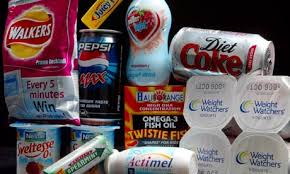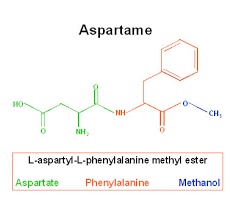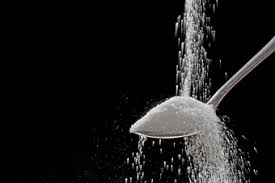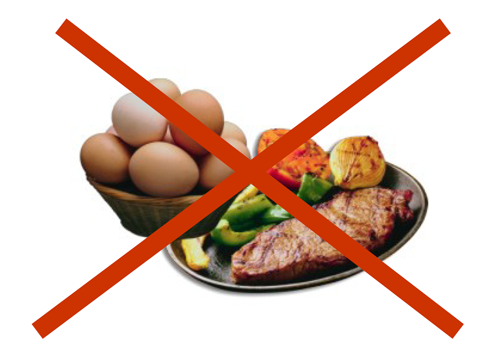Aspartame: a real danger?
Aspartame (APM) is an artificial sweetener and flavour enhancer in low-calorie, with a sweetness about 200 times higher than sugar.

This food additive, approved by the FDA in 1981 and classified in European market with the number E951, is currently one of the most used sweeteners. It is contained in about 6000 types of food, and also in certain medications: beverages, chewing gum, dairy products ,confectionery, dietary products for weight control, and more and more frequently as a table-top sweetener.
Millions of people, of any age, consume aspartame in their daily diet.
The acceptable daily intake established by the agency JECFA (Joint FAO / WHO Expert Committee on Food Additives) is 40mg/kg of body weight.
It is composed of two amino acids, aspartic acid (40%) and phenylalanine (50%), whose carboxyl terminus is esterified with methanol (10%).

History and debates
- Aspartame’s health safety has been the subject of bitter controversy since its discovery in 1965, thanks to James M. Schlatter, a chemist working for GD Searle & Company.

- After the initial authorization of the FDA in August 1974, Dr. John Olney and the lawyer Jim Turner started a petition of signatures in order to oppose the decision of the organization.
In those years, as today , aspartame worried because of his alleged toxic effects on human health, particularly in the nervous system. The FDA suspended its commercial use.
- In 1981 , the FDA , after a great amount of analysis, determined that there is no proven relationship between aspartame and brain damage, so it approved the use of aspartame in a limited number of foods ( mostly dry foods ). In 1983, the authorization was extended to beverages and in 1996 any limitations on its use was abolished , so it was permitted in all foods. In 1994 the use of APM is approved at European level [ European Parliament and Council, 1994 ] .
Food Additive Approval Process Followed for Aspartame, 1987
- The Scientific Committee for Food of the European Commission reaffirms its approval in 2002.
- Today, the debate about the effects of aspartame has turned more than ever , as evidenced by studies and publications about the use of this controversial sweetener.
Effects and mechanisms of action: toxic to humans?
Aspartame is rapidly degraded (hydrolyzed) in the small intestine; even with the ingestion of very high doses (over 200 mg / kg), there are no traces of aspartame into the blood.
What seems dangerous is the liberation of methanol in the body. This doesn’t play a direct action, but it is converted by the Alcohol dehydrogenase (ADH) in formaldehyde, then it is transformed into formic acid by the aldehyde dehydrogenase (ALDH).
In particular, the accumulation of the latter is assumed to be the main cause of toxicity.



However, the amount of methanol in aspartame is less than the one found in citrus fruits, some fruit juices and fermented beverages.
In general, the formic acid is toxic because it inhibits the mitochondrial cytochrome c oxidase, the last complex (IV) involved in the mitochondrial respiratory chain.
This causes a situation of hypoxia in the tissue and metabolic disorders including a significant acidosis.
Methanol and formic acid toxicity: biochemical mechanisms, 1991
Regarding formaldehyde, since 2004, it has been inserted by AIRC (Italian Association for Cancer Research) in the list of substances considered with certainty carcinogenic for humans.
Formaldehyde and Cancer Risk
Various experiments on mice with formaldehyde have been conducted: in those studies a rate of incidence of nasopharyngeal tumors higher than normal was observed. In addition, a recent study of California’s researches (2008) showed that these mutations can occur also in lymphocytes, suggesting a possible relationship with the onset of leukemia.
This aldehyde seems to have a toxic effect on the genome: it interferes with the links between DNA and proteins (phenomenon of "cross-linking"), and it is responsable for chromosomal aberrations.
In particular, formaldehyde induces crosslink between cytosine and lysine in DNA.
This was observed in the nasal mucosa of animals exposed, in particular in rats, in human lymphocytes and in hamster’s lung cells. From the data collected, it is assumed the possible occurrence of leukemia associated with formaldehyde: this can lead to damage in the double helix and chromosomal aberrations in hematopoietic stem or progenitor cells in the bone marrow, promoting the development of leukemia in stem cells.
Formaldehyde exposure and leukemia: A new meta-analysis and potential Mechanisms, 2008
Also Aspartate derives from the degradation of aspartame: it is a common amino acid that can be converted into glutamate. This, if present at high extracellular concentrations, may be harmful to the nervous cells.
But in the ongoing debate, the question we are trying to find an answer is: considered the daily dose (40mg/kg) and the amount present in food commonly consumed, can aspartame be considered dangerous to our health?
- In 2005, there was the publication of a famous study led by the European Foundation of Oncology and Environmental Sciences "Bernardino Ramazzini" in Bologna. This highlights an increased incidence of lymphomas and leukemias in rats after the intake of low doses of aspartame, and suggests a link between formaldehyde released from its metabolism and increased incidence of brain tumors. The study was published in the European Journal of Oncology in July 2005.
Aspartame induces lymphomas and leukemias in rats, 2005
The study was planned on 1,800 rats (900 males and 900 females). In order to simulate a daily intake of the human population, aspartame was added to the standard diet with specific quantities. Treatment of animals started at the age of eight weeks and lasted until natural death of each rat. Afterwards a full autopsy and a histopathological evaluation of all organs and tissues were made.
According to the results of the examination, aspartame causes a dose-related , statistically significant increase of lymphomas and leukemias in kidney of female rats and malignant tumors of peripheral nerve in male rats . This increase was also observed at a dose of 20 mg / kg of body weight, a lower dose than the one allowed by law to humans ( 50-40 mg / kg body weight ) ;
Moreover, the addition of aspartame to food would induce a decrease in food intake correlated with the dose of the compound , without determining a difference in body weight between the treated and untreated animals .

The scandal of the news is immediately echoed in several newspapers ( "Il Manifesto" 17/07/2005 , " Corriere della Sera" , 15/07/2006 , "La Repubblica" , July 15, 2005 ) and in the following years , all over the world , there were publications against the use of this sweetener . Some of the results are the following :
- In December 2010 there was the publication of another study conducted by Ramazzini Institute: aspartame in food seems to induce, since fetal life , tumors in the liver and lung in male mice . In particular, it was seen, in males, a significant dose-related increase of the incidence of hepatocellular and alveolar / bronchiolar carcinomas.
The results of this study confirm the carcinogenicity of APM in rodents , particularly in male individuals .
Aspartame administered in feed, beginning prenatally through life span, induces cancers of the liver and lung in male Swiss mice, 2010
- Between 2010 and 2013, a relationship between aspartame and cell death was observed: using PC12 cells, scientists sought that aspartame causes apoptosis in a dose-related manner . In particular , exposure to aspartame increases the expression of caspase 8 and 9 and cytochrome c . This suggests an apoptosis induced by problems of cellular respiration.
Aspartame-induced apoptosis in PC12 cells, 2013
- In a study conducted on colonies of rats by the University of Cairo in 2012, it was found that the consumption of aspartame leads to genetic alterations and histopathological lesions in the liver and bone marrow. More specifically , these toxicological changes are directly proportional to the duration of exposure to aspartame and the lesions decrease by suspending the administration .
Cytotoxic effect of aspartame (diet sweet) on the histological and genetic structures of female albino rats and their offspring, 2012
- Moreover, in December 2012 were published studies about the effects of aspartame on memory and oxidative stress observed in the brains of mice.
The results suggest that, with repeated doses of aspartame , memory processes appear to be compromised, and there is an increase of oxidative stress in the brain .
Studies on the effects of aspartame on memory and oxidative stress in brain of mice, 2012
- All of these studies, with the related data, were evaluated thoroughly by the European Food Safety Authority ( EFSA). In a press release of 10 December 2013, it was announced that it was completed an exhaustive analysis of all available studies , which shows that " _aspartame and its degradation products are safe for human consumption at current levels of exposure _" , that is the permissible daily dose of 40mg/kg body weight / day.
As stated by the EFSA , the most alarming results refer to other species, while in human no link between aspartame and some damage to the body was found .
With regard to the three main degradation’s products of aspartame (aspartate , phenylalanine and methanol ), the agency states that :
- "The phenylalanine is an amino acid that constitutes the proteins present in many foods . Its toxicity is noted at high levels of intake, in particular it is dangerous for the fetus developing in women suffering from the disease said phenylketonuria (PKU ) .
- The methanol is present or can be released from food such as fruit and vegetables and it is also produced naturally by our body . It becomes toxic when the exposition is extremely high (for example, in the consumption of certain home-distilled spirits) . The methanol derived from aspartame is a small percentage of the total exposure to methanol from other sources .
* Aspartic acid can be converted into glutamate (harmful at high concentrations ), but the EFSA scientists have not observed evidence of neurotoxicity associated with aspartame and they concluded that aspartic acid from aspartame does not raise concerns about the safety of consumers. "
EFSA, 2013
If there are still questions about the effects of aspartame , what is certain is that , because of the content of phenylalanine (1,18g/100g) , the daily dose established is not applicable in patients with phenylketonuria (PKU ) . In fact, they must follow a strict diet low in phenylalanine.
Phenylketonuria
Phenylketonuria (PKU) is a rare genetic disorder (affecting approximately one out of 10,000), an autosomal recessive trait that determines, in its most common form, the lack of an enzyme, phenylalanine hydroxylase (PAH), which is essential for the metabolism of phenylalanine . The absence or deficiency of this enzyme results in the presence of phenylalanine and its metabolites in blood and urine, and can have serious effects on the nervous system.
There is also a form of phenylketonuria induced by the deficiency of tetrahydrobiopterin (BH4), a co-factor of PAH. In these cases, administering tetrahydrobiopterin orally, the levels of plasmatic phenylalanine are reduced in a very short time.

The disease is caused by mutations in the PAH gene (Phenylalanine Hydroxylase, located on chromosome 12, locus q22-q24), coding for the enzyme phenylalanine hydroxylase, active especially in the liver. About 500 possible mutations associated with PKU were found; they can be of various kinds: "missense" point mutations, splicing defects, partial deletions ...

Under normal conditions, the phenylalanine hydroxylase, together with tetrahydrobiopterin (BH4), converts the essential amino acid phenylalanine into tyrosine. But, when the enzyme is not functioning, phenylalanine is accumulated in the blood and in some tissues of the body (in the bloodstream, normal levels are 1 mg/100ml, in cases of PKU reach 20 mg/100ml).
The accumulated phenylalanine is partly converted into phenylpyruvate and phenylacetate, which are excreted through the urine (high urinary levels of phenylalanine and derivatives are among the first indicators of PKU). Phenylalanine is able to cross the blood-brain barrier and accumulates in nerve tissue, causing mental retardation, growth retardation and early death.
The neurochemistry of phenylketonuria, 2000
Phenylketonuria (PKU), 2008
Phenylalanine Hydroxylase Deficiency, 2000

As the image shows, in healthy subjects and patients with PKU, fluctuations of phenylalanine in portal blood are similar, while in the systemic circulation they appear to be higher in those affected. This is due to a lower activity of PAH in the liver. This corresponds to a higher concentration of phenylalanine in the nervous tissue, a quantity proportional to the extent of brain damage.
The deficiency of tyrosine, resulting from the lack of PAH, also leads to an insufficient production of molecules such as neurotransmitters epinephrine, norepinephrine, dopamine, and the precursor of melanin, the DOPA.
Diagnosis
Because of the serious consequences of Phenylketonuria, which is asymptomatic at birth, European and American states have instituted analysis of all newborns for early diagnosis of PKU.
The method mostly used was Guthrie test, also known as the Guthrie’s bacterial inhibition assay. This is a screening test able to determine the levels of phenylalanine in the blood. In recent years, it has been gradually replaced by new techniques such as tandem mass spectrometry, which can detect a wider variety of congenital diseases.

The Guthrie test consists in placing a drop of blood (taken from newborn’s heel in the second or third day of life) on a disk of filter paper. Afterwards, this is put in contact with a culture of Bacillus subtilis, with β-2-tienialanina, a chemical substance which inhibits the growth bacteria. It acts as an agonist of phenylalanine (it prevents the bacteria from feeding themselves with phenylalanine available in the culture). A blood sample of a child with phenylketonuria, provides enough extra phenylalanine for the bacteria, so it can grow despite the presence of β-2-tienialanina. Bacterial growth is therefore a signal of high levels of phenylalanine (positive test) , so the infant must be subjected to further analysis.
The majority of cases of undiagnosed PKU are not due to false negative test results, but inadequate samples, errors in reporting the results or failure to follow up. False positive results may be obtained from babies born prematurely or who have been treated with antibiotics in the week after birth.
Symptoms
At birth, no relevant symptoms are observed, but after a while, the first symptoms appear: skin rash, nausea, vomiting, irritability,eczematous and urine with a rather pungent odor, due to the presence of phenylalanine that isn’t correctly metabolized. Gradually tremors, hyperreflexia, muscle hypertonia can appear.
Because of the lack of tyrosine and DOPA, the precursor of melanin, individuals suffering from this disease have fair skin, blue eyes and often blond hair, due to skin decoloration.
In the long term, individuals develop a progressive mental retardation.
PKU can be very dangerous in pregnancy: elevated levels of phenylalanine in the mother's blood may have teratogenic effects on the fetus. Since the first two months, the fetus is at risk of heart problems and microcephaly, which can result in a severe mental retardation.
Prophylaxis
Phenylketonuria can be kept under control with a diet low in phenylalanine and / or with administration of BH4 (sapropterin ) in BH4-responsive patients. The daily requirements of phenylalanine are estimated with blood tests carried out in PKU patients, for whom it is believed that the optimum values of phenylalanine in blood are between 2.0 and 6.0 mg/100 ml.
Some data suggest that a lower protein intake reduces within 24 hours the oscillations of phenylalanine in the blood, and therefore in the brain as well.
Similarly, in responding patients, BH4 reduces blood concentrations of this amino acid.
Fluctuations in phenylalanine concentrations in phenylketonuria: A review of possible relationships with outcomes, 2013
Sources of phenylalanine
Phenylalanine is an essential aromatic amino acid present in most animal and vegetable proteins: for example, we can find it not only in aspartame (see above), but also in dried fruit, meat, cocoa, cheese, fish, legumes, etc ... So, this food should be avoided in case of PKU.

The table shows (in descending order) the content of phenylalanine in various types of food (the most common ones). This allows to evaluate and mitigate any risks on the basis of the diet.
The values are expressed in grams, per 100 grams of food.
| Food | Phenylalanine |
|---|
| Albumen | 4,74g/100g |
| Soy proteins | 4,6g/100g |
| Salted cod | 2,45g |
| Parmesan | 2g |
| brewer’s yeast | 1,75g |
| Powder milk | 1,74g |
| Dried parsley | 1,7g |
Cheese (fontina,
Emmenthal
gruyere...) | 1,7-1,4g |
| Bacon (pork) | 1,5g |
| Yolk | 1,5g |
| Loin of veal, braised | 1,35g |
| Peanuts | 1,33g |
| Lentils | 1,27g |
| Mozzarella | 1,26g |
| Basil | 1,25g |
| Rabbit | 1,24g |
| Beans | 1,24g |
| Chicken/veal breast | 1,23g |
| Pork ribs | 1,19g |
| Aspartame | 1,18g |
| Almonds | 1,1g |
| Tuna | 1,15g |
| Walnuts | 1,09g |
| Salmon | 1,06g |
| Pistachios | 1,05g |
Other fishes (perch,
trout, swordfish...) | 1-0,8g |
| Roast chicken | 0,9g |
| Cocoa | 0,94g |
| Mussels | 0,85g |
| Hazelnuts | 0,6g |
| Cookies | 0,4g |
| Rice | 0,3g |
| Pasta (with egg) | 0,2g |
| Dark chocolate | 0,18g |
| French fries | 0,11g |
Phenylalanine is almost absent in vegetables (such as spinach, broccoli, peppers, carrots, aubergines, tomatoes, potatoes ...), mushrooms and fruits in general (oranges, kiwi, grapefruit, strawberries, peaches, grapes, prunes , apricots ...) and in derived jams.
It is absent even in tea and various oils (olive, coconut, peanuts, soy ..)
Phenylalanine in food
Notes:
Other (multimedial) sourches:
- www.wikipedia.org
- www.ramazzini.org
- www.efsa.europa.eu
- www.valori-alimenti.com